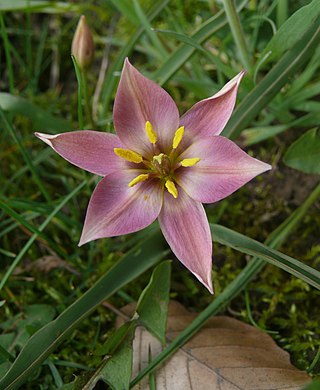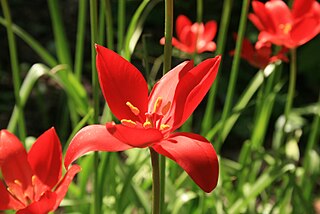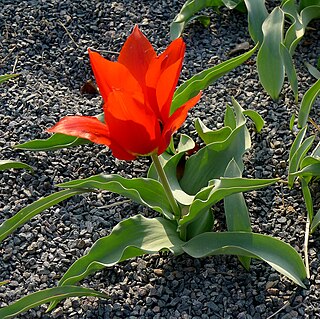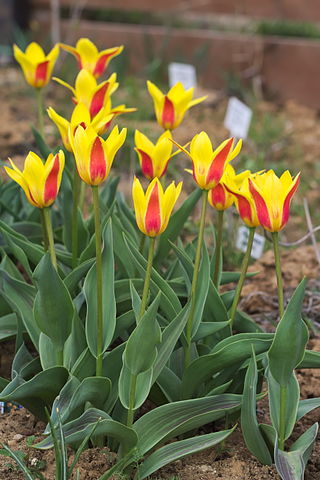
The lily family, Liliaceae, consists of about 15 genera and 610 species of flowering plants within the order Liliales. They are monocotyledonous, perennial, herbaceous, often bulbous geophytes. Plants in this family have evolved with a fair amount of morphological diversity despite genetic similarity. Common characteristics include large flowers with parts arranged in threes: with six colored or patterned petaloid tepals arranged in two whorls, six stamens and a superior ovary. The leaves are linear in shape, with their veins usually arranged parallel to the edges, single and arranged alternating on the stem, or in a rosette at the base. Most species are grown from bulbs, although some have rhizomes. First described in 1789, the lily family became a paraphyletic "catch-all" (wastebasket) group of lilioid monocots that did not fit into other families and included a great number of genera now included in other families and in some cases in other orders. Consequently, many sources and descriptions labelled "Liliaceae" deal with the broader sense of the family.

Tulipa turkestanica, the Turkestan tulip, is a species of tulip native to Central Asia. It was first described by Eduard August von Regel in 1873 as a variety of T. sylvestris, then elevated to full species status two years later.

Tulipa gesneriana, the Didier's tulip or garden tulip, is a species of plant in the lily family, cultivated as an ornamental in many countries because of its large, showy flowers. This tall, late-blooming species has a single blooming flower and linear or broadly lanceolate leaves. This is a complex hybridized neo-species, and can also be called Tulipa × gesneriana. Most of the cultivars of tulip are derived from Tulipa gesneriana. It has become naturalised in parts of central and southern Europe and scattered locations in North America.

Tulips are spring-blooming perennial herbaceous bulbiferous geophytes in the Tulipa genus. Their flowers are usually large, showy, and brightly coloured, generally red, orange, pink, yellow, or white. They often have a different coloured blotch at the base of the tepals, internally. Because of a degree of variability within the populations and a long history of cultivation, classification has been complex and controversial. The tulip is a member of the lily family, Liliaceae, along with 14 other genera, where it is most closely related to Amana, Erythronium, and Gagea in the tribe Lilieae.

Tulipa armena is a species of flowering plant in the Liliaceae family. It is referred to by the common name Armenian tulip, and is native to the historical Armenian Highlands as the name implies; current regions of Armenia, modern day Turkey, Iran, South Caucasus, and Azerbaijan.

Tulipa humilis is a species of flowering plant in the lily family, found in Syria, Lebanon, Israel, Turkey, Iran, and the North Caucasus region of Russia. The flowers are pink with yellow centers. Its preferred habitat are rocky mountain slopes. It is known by several other names in horticulture.

Tulipa sprengeri, or Sprenger's tulip, is a wild tulip from the Pontic coast of Turkey. It is quite rare and possibly extinct in the wild, but widely cultivated as an ornamental.

Tulipa suaveolens, synonym Tulipa schrenkii, the van Thol tulip or Schrenck's tulip, is a bulbous herbaceous perennial of species of tulip (Tulipa) in the family of the Liliaceae. It belongs to the section Tulipa. It is the probable wild ancestor of the garden tulip.

Tulipa cypria, the Cyprus tulip, is a tulip, an erect perennial bulbous herb, 15–40 cm high, with glabrous, glaucous leaves. It has four leaves which are alternate, simple, entire and fleshy. The two lower leaves are larger, lanceolate, 10-20 x 2–6 cm, with conspicuously undulate margins while the two higher leaves are much smaller, nearly linear. One terminal showy flower, perianth cup shaped, of six free, petaloid segments, 2.5-9 x 1-3.5 cm, with dark blood-red colour, internally with a black blotch bordered by a yellow zone. It flowers March–April. The fruit is a capsule.

Tulipa sylvestris, the wild tulip or woodland tulip, is a Eurasian and North African species of wild tulip, a plant in the lily family. Its native range extends from Portugal and Morocco to western China, covering most of the Mediterranean and Black Sea Basins, and Central Asia. The species is also cultivated as an ornamental and naturalized in central and northern Europe as well as a few scattered locations in North America. It was first recorded as being naturalised in Britain in the late 17th century.

Tulipa eichleri, commonly known as Eichler tulip or Eichler's tulip, is a species of tulip. It is a bulbous flowering perennial with long green leaves,deep red flowers with a central black blotch, coming from the Caucasus Mountains.

Tulipa hungarica, the Danube tulip, Banat tulip or Rhodope tulip, is a species of flowering plant in the family Liliaceae. It is also in the subgenus Tulipa. It is found on the rocky mountainsides of Bulgaria, Romania, Hungary and Slovenia, especially along the gorges of the river Danube. It has small bright yellow flowers in spring and blue-grey leaves.

Tulipa alberti, or Albert's tulip, is a species of flowering plant in the family Liliaceae. It has long reddish, orange or pink flowers. It comes from the mountains of Central Asia.

The taxonomy of Tulipa places the genus in the family Liliaceae, and subdivides it as four subgenera, and comprises about 75 species.

Tulipa montana is a species of tulip native to the mountains of Iran and Turkmenistan. With its deep red petals it has been proposed as a candidate for the Biblical Rose of Sharon, whose identity is unknown.

Tulipa fosteriana is a species of tulip, native to the Pamir Mountains and nearby areas of Afghanistan, Kyrgyzstan, Tajikistan and Uzbekistan.

Tulipa kaufmanniana, the water lily tulip, is a species of tulip native to Central Asia.

Tulipa greigii, is a species of tulip native to Central Asia and Iran.

Tulipa praestans is a species of tulip native to the mountains of Tajikistan. Many well known cultivars have been formed from the original plant.
Tulipa ferganica is a species of flowering plant in the family Liliaceae, native to Uzbekistan and Kyrgyzstan. It has bright yellow flowers with the three outer petals brushed a brownish-pink, and its slender grey-green leaves have wavy edges. A bulbous geophyte reaching 15 to 25 cm, it is typically found growing on the rocky hillsides surrounding the Fergana Valley. One of the so-called species tulips, it may be available from specialty suppliers.
















